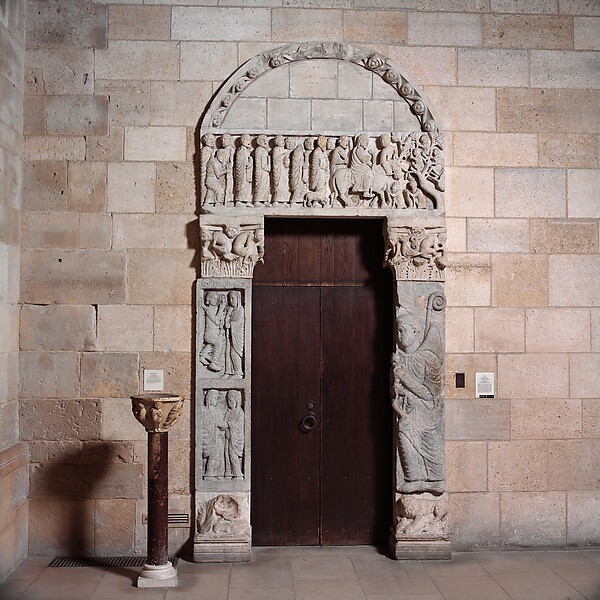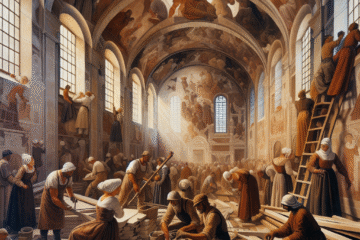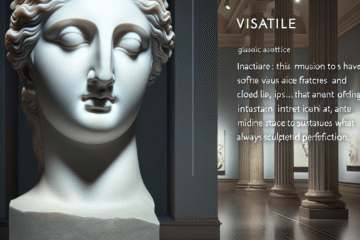
Image title: Portal from the Church of San Leonardo al Frigido
Medium: Marble (Carrara marble)
Date: ca. 1175
Source:
The Met Collection
“
The secret of getting ahead is getting started.
”
— Mark Twain
Melted Stone: The Secret History of Softness in Sculpture
Introduction: When Stone Breathes
To sculpt is to take what is solid and transform it into something seemingly malleable, alive. For millennia, artists have worked with stone, bronze, marble, and most recently, industrial materials, to create forms that appear pliant, emotional, even vulnerable. The contradiction is at the heart of sculpture’s magic: how can marble—quarried rock from the earth—become soft flesh, draped fabric, collapsing bodies, or weightless clouds? This exploration into the hidden art of softness in sculpture uncovers a remarkable through-line: from ancient Greek marble to conceptual contemporary installations, a select group of sculptors across ages have mastered the illusion of texture and feeling in the most unyielding media.
1. Hellenistic Greece: Emotion in Marble
It was during the Hellenistic period (c. 323–31 BCE) that sculptors fully embraced the possibility of motion and emotion in stone. Departing from the restraint of Classical sculpture, Hellenistic figures showed anguish, exuberance, and physical vulnerability. Consider the Laocoön and His Sons, the dynamic masterpiece where sinewed bodies twist in pain under the grip of serpents. Or the Sleeping Hermaphroditus, whose reclining form captures both the tension and softness of flesh atop a sculpted mattress—where even the supposedly hard bedding appears indented and yielding. The Greeks believed in kalokagathia—the harmony of beauty and virtue—which encouraged artists to blend physical perfection with emotional resonance.
2. Renaissance Revival: Drapery and Flesh
The Renaissance marked a return to classical ideals, but with newfound techniques in precision and realism. Artists like Michelangelo pushed carrara marble to its expressive limits. His Pietà is a study in contrasts: the lifeless weight of Christ’s body rests on Mary’s lap, and both figures—carved from a single block—are rendered so intricately that the marble seems to breathe. Michelangelo’s mastery lay in his capacity to make stone feel light, touchable, alive. Italian sculptors of this period explored softness not only through facial expressions but especially through drapery—an enduring strategy to suggest flow, texture, and warmth in an otherwise unyielding medium.
3. Baroque Excess: The Marble Mirage
If the Renaissance admired proportion, the Baroque worshipped movement. Gian Lorenzo Bernini, perhaps the greatest Baroque sculptor, revolutionized marble technique with his works such as The Ecstasy of Saint Teresa. Here, the saint’s raptured expression and billowing robes look impossibly airy. Bernini was a magician of texture—creating the visual illusion of silk, skin, and even feathers in stone. Another seminal piece, Apollo and Daphne, depicts a woman transforming into a tree; bark, leaves, and hair emerge mid-transformation, each delicately carved. This was no longer confined to mimicking softness—it was alchemy, where marble transmuted into narrative and myth.
4. Modernity and Abstraction: Steel, Space, and Suggestion
The 20th century brought radical conceptual shifts. Artists like Constantin Brâncuși abandoned detailed realism in favor of abstraction that still evoked softness. His Sleeping Muse simplifies features into pure curvature, yet the bronze surface glows with a palpable serenity. Meanwhile, Henry Moore’s curvilinear forms suggested reclining figures or maternal symbols, often carved in wood or cast in bronze. Their monumental presence still conveyed vulnerability and fluidity.
Advances in metallurgy and casting allowed artists to manipulate steel and other rigid materials into seemingly weightless constructions. The very notion of ‘softness’ evolved—no longer about mimicking flesh or drapery, but about invoking emotional or sensory perception through shape and space.
5. Contemporary Alchemy: Softness as Concept
In today’s art scene, softness is as much philosophical as physical. Artists like Anish Kapoor create voids and curvatures that seduce the viewer’s gaze into endless folds, while Jeppe Hein’s mirrored installations bend space into gentle distortions. Others, like Sarah Lucas, ironically use hard materials such as concrete or metal to mimic cushions, innards, or fleshy forms—challenging perceptions of gender, corporeality, and humor.
Technology also plays a key role. With 3D modeling, laser-cutting, and polymer experimentation, contemporary sculptors like Alice Maher and Ernesto Neto make softness immediate, exaggerated, and surreal. Neto’s immersive mesh installations allow fabric and spices to mimic organic, womb-like spaces—transforming the viewer’s relationship to gravity, texture, and sensory perception.
Conclusion: The Paradox of Yielding Matter
From the quarries of ancient Greece to the conceptual galleries of the 21st century, artists have a long-standing affair with the impossible—making the hard appear soft. Whether through technical finesse, poetic abstraction, or technological innovation, they invite us to question our assumptions about material, sensation, and perception. In sculpted softness, we find not only deception, but deep emotional truth. It whispers to us: nothing is as solid as it seems.

Image description:
Soft Sculptural Painting by Polly Alice McCann
License:
CC BY-SA 4.0
Source:
Wikimedia Commons
Useful links:


